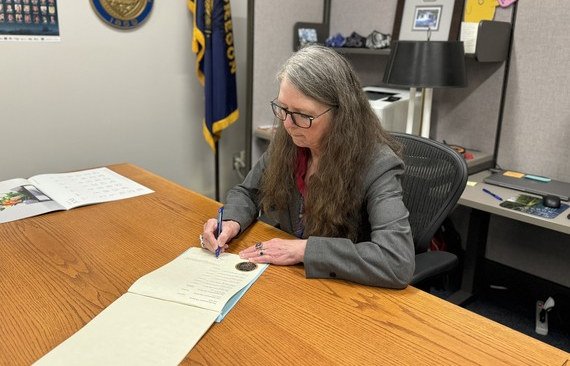Oregon
Sea level rise threatens critical sites along Oregon coast, analysis warns

FILE: The Pacific City State Airport in Oregon’s Tillamook County floods on Nov. 7, 2022, during a phenomenon known as king tides, which is when a full or new moon causes ocean tides to reach their highest point in the year. Climate change could lead to more significant frequent flooding in the coming decades, according to an analysis released Tuesday.
Photo courtesy of the Oregon King Tides Project
Rising ocean levels could threaten dozens of water treatment plants, fire and police stations and other critical infrastructure along Oregon’s coastline by 2050, according to an analysis by a science advocacy group that published Tuesday.
The Union of Concerned Scientists estimates that about 26 sites in Oregon could flood twice a year by 2050, including waste and water treatment plants, fire and police stations, electrical substations and industrial contamination sites. The nonprofit estimates that number could increase to 86 critical sites flooding twice annually by the end of the century. That’s assuming sea levels rise 3.2 feet by 2100.
The analysis maps critical infrastructure sites that are vulnerable to future flooding across the country. The East Coast appears to get hit the hardest. Some cities there, like Boston and Miami, are already disappearing into the ocean, giving West Coast cities a glimpse into what the future may hold for them.
In Oregon, critical infrastructure appears most vulnerable around Astoria, Tillamook and Coos Bay.
About two-dozen electrical hubs, post offices, waste treatment facilities and other critical infrastructure could flood twice annually by 2050, according to an analysis of federal data by the Union of Concerned Scientists.
Map courtesy of the Union for Concerned Scientists

Kristina Dahl, climate scientist at the Union of Concerned Scientists, said local governments should prepare now for a future when floods could inundate sewers, disrupt electrical power and destroy homes.
“We encourage communities to do a really detailed risk assessment,” Dahl said. “Once they know what’s at risk within the community, they can start to prioritize.”
The report calls on policymakers to increase funding for coastal infrastructure, particularly in areas with lower-than-average incomes. It also encourages local governments to protect residents in subsidized housing that could be flooded by helping them relocate.
The global average sea level has been rising 3.3 millimeters — about one-eighth of an inch — every year since the 1990s, according to satellite data from NASA. Oceans are rising as a direct result of climate change, as warming temperatures melt glaciers.
Carbon dioxide emissions from burning fossil fuels are the biggest contributors to global warming. Those emissions reached record levels last year, which was also the hottest year on record.

Oregon
U.S. Supreme Court sides with Oregon city, allows ban on homeless people sleeping outdoors • Maine Morning Star

The U.S. Supreme Court Friday sided with a local ordinance in Oregon that effectively bans homeless people from sleeping outdoors, and local governments will be allowed to enforce those laws.
In a 6-3 decision, Justice Neil Gorsuch wrote in the opinion that the enforcement of those local laws that regulate camping on public property does not constitute the Eighth Amendment’s prohibition on cruel and unusual punishment.
“Homelessness is complex. Its causes are many. So may be the public policy responses required to address it,” he wrote. “The Constitution’s Eighth Amendment serves many important functions, but it does not authorize federal judges to wrest those rights and responsibilities from the American people and in their place dictate this Nation’s homelessness policy.”
The case originated in Grants Pass, a city in Oregon that argues its ordinance is a solution to the city’s homelessness crisis, which includes fines and potential jail time for repeat offenders who camp or sleep outdoors.
Justice Sonia Sotomayor wrote a dissent arguing that the ordinance targets the status of being homeless and is therefore a violation of the Eighth Amendment.
“Grants Pass’s Ordinances criminalize being homeless,” she wrote. “The Ordinances’ purpose, text, and enforcement confirm that they target status, not conduct. For someone with no available shelter, the only way to comply with the Ordinances is to leave Grants Pass altogether.”
During oral arguments, the justices seemed split over ideological lines, with the conservative justices siding with the town in Oregon, arguing that policies and ordinances around homelessness are complex, and should be left up to local elected representatives rather than the courts.
The liberal justices criticized the city’s argument that homelessness is not a status protected under the Eighth Amendment’s prohibition of cruel and unusual punishment. The liberal justices argued the Grants Pass ordinance criminalized the status of being homeless.
The Biden administration took the middle ground in the case, and U.S. Deputy Solicitor General Edwin Kneedler offered partial support.
“It’s the municipality’s determination, certainly in the first instance with a great deal of flexibility, how to address the question of homelessness,” he said during oral arguments in late April.
This is a breaking news story and will be updated.
Oregon
OHA: Oregon needs 3,700 mental health, substance abuse treatment beds, closing gap could cost $170 million a year – KTVZ

SALEM, Ore. (KTVZ) – Oregon needs up to 3,700 adult mental health and substance use treatment beds to close existing gaps and meet future service projections, according to a final Oregon Health Authority study of the state’s behavioral health continuum of care.
The findings are part of an assessment that Governor Tina Kotek directed the OHA to commission last year. The report was produced by Public Consulting Group, a public sector solutions implementation and operations improvement firm that has produced similar studies in Washington and other states.
The findings inform an ongoing funding and implementation effort that state leaders are committed to pursue, which could take several biennia to complete, according to OHA’s news release, which follows in full:
According to the final Behavioral Health Residential + Facility Study report, closing the gap could require investments of as much as $170 million per year over the next five years and the creation of approximately 650 new beds per year.
The final report includes a new five-year funding recommendation that recognizes the importance of:
- Increasing the behavioral health workforce to support expanded capacity.
- Improving access to mental health and substance use disorder support services to help individuals stay within their communities.
- Expanding supportive and transitional housing opportunities.
State health officials will continue to work with Governor Kotek and the Legislature to apply the study’s findings and guide investments toward closing the gap in treatment services.
“We don’t get to choose between adding beds, and adding workforce. We must do both in order to make real change in our behavioral health system. It’s important to note that capacity in Oregon’s behavioral health system is dynamic, and the data in the report represent a point-in-time snapshot of one part of a broader continuum of care,” said OHA Behavioral Health Director Ebony Clarke.
“This report provides us with critical data to inform how we prioritize the creation of more treatment beds and it also underscores the broader understanding that we need to continue to invest in solutions that reduce the number of beds needed,” Clarke said. “We do this through investing in protective factors and earlier intervention – additional community-based programming, crisis and outpatient programs, in addition to other supportive services – to prevent people who are experiencing mental illness or substance use from progressing to a level of severity in their illnesses that would require treatment in a more acute setting.”
The final report follows the draft preliminary report released in February.
At the direction of OHA, the final report reflects updated data for the facilities within scope for this study. Although there is no perfect methodology for determining the appropriate number of high-acuity beds in a behavioral health system, PCG used state and national data sets, findings from peer-reviewed literature and surveys of treatment facilities to estimate mental health and SUD treatment bed capacity and needs within the continuum of care. PCG worked at the direction of OHA to include Oregon-specific data.
Even as the report was finalized, state officials were moving quickly to supplement capacity and have already identified several short-horizon “priority” projects, which are likely to bring community beds online within the next year or two and to address what are considered critical service gaps. OHA is working to publish a dashboard later this summer that will track and highlight progress toward new beds coming online.
Over the past four years, the Oregon Legislature has invested more than $1.5 billion to expand behavioral health treatment capacity, raise provider payment rates and stabilize the treatment workforce. Oregon’s current capacity shortfall would be even greater without these investments.
According to the report, recent legislative investments from HB 5202 (2022) and HB 5024 (2021) have supported the creation of 356 new licensed mental health residential beds (exclusive of adult foster homes), SUD residential, and withdrawal management beds, which are under construction and scheduled to open by the third quarter of 2025.
Oregon
Oregon Secretary of State Griffin-Valade certifies May primary election results; 35% of voters returned ballots – KTVZ

SALEM, Ore. (KTVZ) — Oregon Secretary of State LaVonne Griffin-Valade certified the results of the 2024 primary election on Thursday. Official election results are available on their website.
“Oregonians are voters, as proven with the success of this election,” Griffin-Valade said. “This primary election was one of the most secure in Oregon’s history, and the November general election will be the same.”
According to the statistics released Thursday by the Elections Division, final voter turnout for the primary election was about 35% of registered voters.
“My deepest gratitude goes out to all of the county clerks and elections officials across Oregon who worked tirelessly to ensure this election went smoothly,” said Secretary Griffin-Valade. “They are on the front lines making sure our democracy works, and I couldn’t be prouder of their efforts.”
For more information, visit our website: OregonVotes.gov
KTVZ NewsChannel 21 is committed to providing a forum for civil and constructive conversation.
Please keep your comments respectful and relevant. You can review our Community Guidelines by clicking here
If you would like to share a story idea, please submit it here.
-

 News1 week ago
News1 week agoNYC pastor is sentenced to 9 years for fraud, including taking a single mom's $90,000
-

 News1 week ago
News1 week agoRead the Ruling by the Virginia Court of Appeals
-

 News1 week ago
News1 week agoTracking a Single Day at the National Domestic Violence Hotline
-

 News1 week ago
News1 week agoSupreme Court upholds law barring domestic abusers from owning guns in major Second Amendment ruling | CNN Politics
-

 World1 week ago
World1 week agoOrbán ally-turned-rival joins EPP group in European Parliament
-

 Politics1 week ago
Politics1 week agoTrump classified docs judge to weigh alleged 'unlawful' appointment of Special Counsel Jack Smith
-

 Politics1 week ago
Politics1 week agoSupreme Court upholds federal gun ban for those under domestic violence restraining orders
-

 Fitness1 week ago
Fitness1 week agoWhat's the Least Amount of Exercise I Can Get Away With?

/cdn.vox-cdn.com/uploads/chorus_asset/file/25301215/STK463_SCOTUS_B.jpg)












